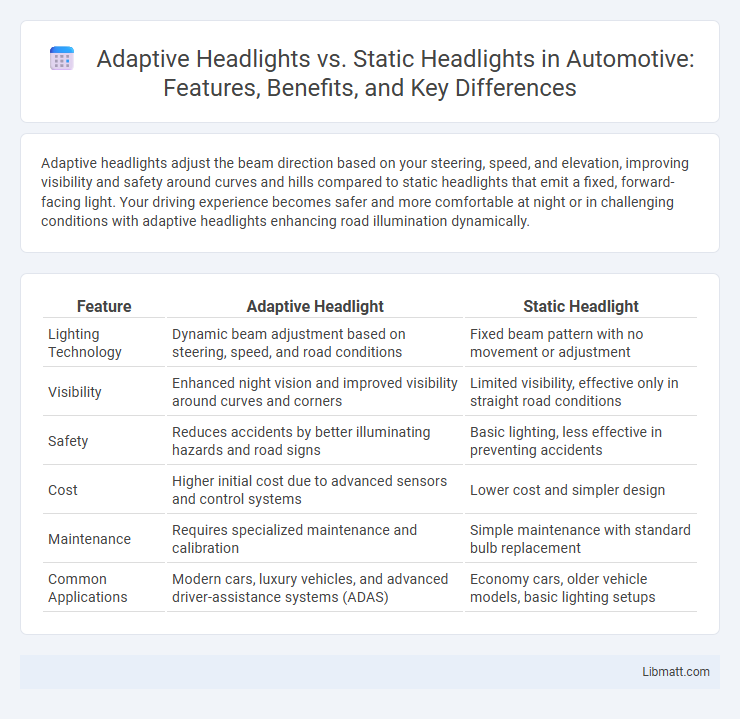Adaptive headlights adjust the beam direction based on your steering, speed, and elevation, improving visibility and safety around curves and hills compared to static headlights that emit a fixed, forward-facing light. Your driving experience becomes safer and more comfortable at night or in challenging conditions with adaptive headlights enhancing road illumination dynamically.
Table of Comparison
| Feature | Adaptive Headlight | Static Headlight |
|---|---|---|
| Lighting Technology | Dynamic beam adjustment based on steering, speed, and road conditions | Fixed beam pattern with no movement or adjustment |
| Visibility | Enhanced night vision and improved visibility around curves and corners | Limited visibility, effective only in straight road conditions |
| Safety | Reduces accidents by better illuminating hazards and road signs | Basic lighting, less effective in preventing accidents |
| Cost | Higher initial cost due to advanced sensors and control systems | Lower cost and simpler design |
| Maintenance | Requires specialized maintenance and calibration | Simple maintenance with standard bulb replacement |
| Common Applications | Modern cars, luxury vehicles, and advanced driver-assistance systems (ADAS) | Economy cars, older vehicle models, basic lighting setups |
Introduction to Headlight Technologies
Adaptive headlights utilize sensors and motorized mechanisms to adjust the beam direction and intensity based on vehicle speed, steering angle, and road conditions, enhancing visibility and safety during night driving. Static headlights provide a fixed beam pattern with no dynamic adjustment, offering basic illumination without consideration for changes in environment or vehicle movement. Advanced adaptive lighting systems often integrate with other vehicle technologies, such as GPS and cameras, to optimize lighting performance in real-time.
What Are Adaptive Headlights?
Adaptive headlights are advanced lighting systems designed to enhance nighttime visibility by adjusting the direction and intensity of the light beam based on your vehicle's speed, steering angle, and road conditions. Unlike static headlights that project a fixed beam, adaptive headlights pivot to illuminate curves and corners, improving safety during nighttime driving. This technology helps you see obstacles and pedestrians earlier, reducing the risk of accidents on winding or poorly lit roads.
What Are Static Headlights?
Static headlights are traditional automotive lighting systems that provide a fixed beam pattern, illuminating only the area directly in front of the vehicle. These headlights do not adjust their direction or intensity based on steering input or road conditions, which can limit visibility on curves or uneven terrain. Understanding the limitations of static headlights helps you appreciate the enhanced safety features offered by adaptive headlight technology.
Key Differences: Adaptive vs. Static Headlights
Adaptive headlights adjust the beam direction based on steering angle, vehicle speed, and road conditions, enhancing visibility around curves and during turns. Static headlights emit a fixed beam pattern that does not change with vehicle movement, providing consistent but limited illumination in straight paths. The key difference lies in adaptive headlights offering dynamic lighting tailored to driving conditions, while static headlights provide a constant, unresponsive light output.
Advantages of Adaptive Headlights
Adaptive headlights improve nighttime driving safety by dynamically adjusting the beam direction based on steering angle, speed, and road curvature, enhancing visibility around curves and bends. They reduce glare for oncoming traffic by automatically dimming high beams, preventing accidents caused by blinding lights. Compared to static headlights, adaptive systems offer superior illumination efficiency and better response to changing road conditions, significantly enhancing overall driving confidence.
Benefits of Static Headlights
Static headlights provide consistent and reliable illumination, making them cost-effective and simple to maintain compared to adaptive headlights. Their fixed beam pattern ensures predictable light distribution, reducing potential glare for oncoming drivers. You benefit from straightforward functionality and durability, especially in standard driving conditions without complex environmental changes.
Safety Comparison: Adaptive and Static systems
Adaptive headlights enhance safety by dynamically adjusting the beam direction based on vehicle speed, steering angle, and road conditions, improving visibility around curves and during turns. Static headlights provide constant, fixed beams that may limit illumination in critical areas, increasing the risk of missed hazards on winding or uneven roads. Your driving experience becomes safer with adaptive systems, especially in low-light or challenging environments, by reducing blind spots and glare for oncoming traffic.
Impact on Nighttime and Weather Driving
Adaptive headlights significantly improve visibility during nighttime and adverse weather conditions by automatically adjusting the beam direction based on steering input and vehicle speed, providing better illumination on curves and around obstacles. Static headlights offer fixed illumination patterns that can limit visibility on winding roads and in poor weather, increasing the risk of accidents. Your driving safety increases with adaptive headlights as they enhance real-time responsiveness to changing road and weather conditions.
Cost and Maintenance Considerations
Adaptive headlights typically incur higher initial costs due to advanced sensors and motorized components, while static headlights are more affordable and widely available. Maintenance expenses for adaptive headlights can be greater because of their complex electronics and potential need for specialized repairs. Static headlights generally have lower upkeep costs and simpler replacement procedures, making them more budget-friendly over time.
Choosing the Right Headlight for Your Vehicle
Adaptive headlights enhance nighttime visibility by automatically adjusting beam direction based on steering angle and vehicle speed, improving safety on curves and hills. Static headlights provide a fixed beam pattern, offering reliability and simplicity but limited adaptability to changing road conditions. Selecting the right headlight depends on driving habits, vehicle type, and budget, with adaptive headlights favored for frequent night driving and dynamic road environments.
Adaptive headlight vs Static headlight Infographic

 libmatt.com
libmatt.com